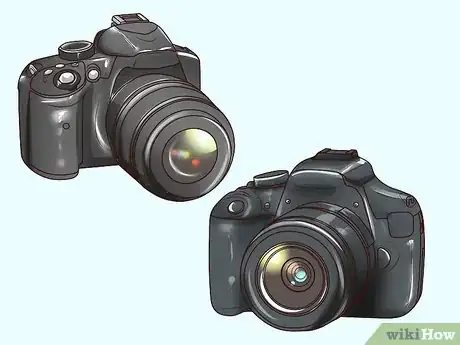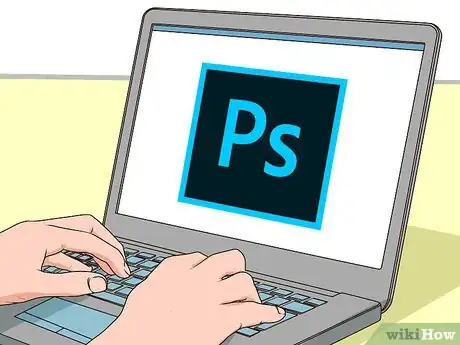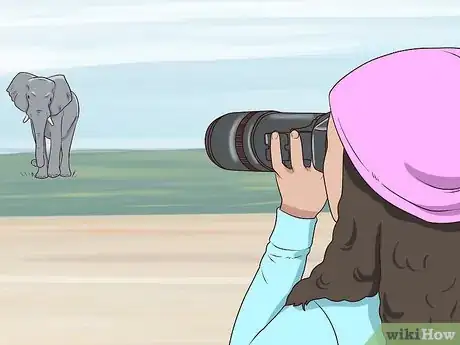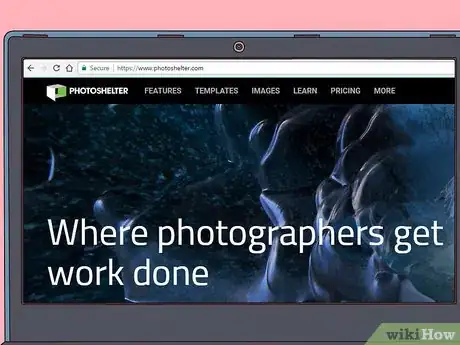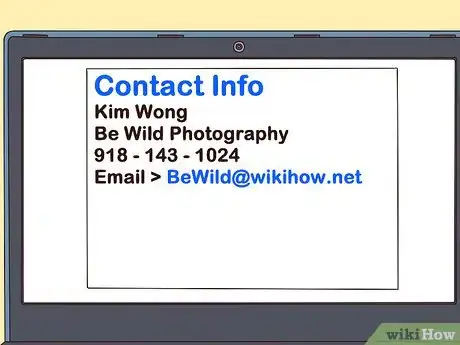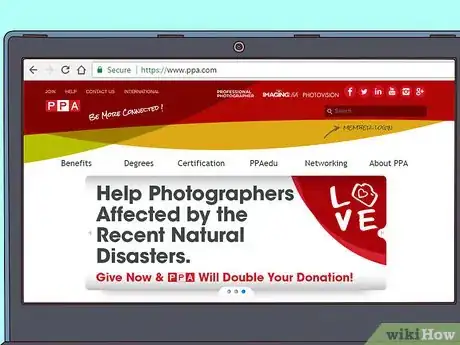This article was co-authored by Victoria Sprung. Victoria Sprung is a Professional Photographer and the Founder of Sprung Photo, a wedding photography studio based in Chicago, Illinois. She has over 13 years of professional photography experience and has photographed over 550 weddings. She has been chosen for Wedding Wire's "Couple’s Choice" Award eight years in a row and The Knot's "Best of Weddings" award five years in a row. Her work has been featured in People Magazine, Time Out Chicago, Chicago Magazine, the Chicago Reader, Rangefinder, The Chicago Sun-Times, and Pop Sugar.
There are 9 references cited in this article, which can be found at the bottom of the page.
wikiHow marks an article as reader-approved once it receives enough positive feedback. In this case, 100% of readers who voted found the article helpful, earning it our reader-approved status.
This article has been viewed 115,268 times.
Making a living as a photographer is as challenging as it is rewarding. By taking photos and starting your own projects, you can begin compiling photos to create your online portfolio. Make sure your portfolio is simple and easy to navigate. Once your portfolio is set up, browse job search sites and network like crazy to find jobs!
Steps
Gaining the Necessary Training and Experience
-
1Purchase the necessary gear. If you are just starting out, buy an entry-level DSLR camera. In addition to the camera, you will need a tripod and a camera lens, like a 50mm prime lens. Lighting is also important, so make sure to invest in an external flash.[1] [2]
- Alternatively, buying a camera that is a step above entry-level will enable you to develop your camera skills.
- If you are on a budget, buy your materials used as opposed to brand new.
-
2Take as many photos as possible. Bring your camera with you everywhere. Whenever you feel inspired, take photos. Additionally, make weekend plans to shoot specific destinations, or to take pictures of people or models. This is a great way to learn how to use your camera and gear while compiling photos.[3]
- Visit the beach, park, or a city centre to find a variety of scenes to shoot.
Advertisement -
3Complete small photography projects. Plan a couple projects that you can complete in 1 to 2 months. Use the style of photography that you want to specialize in. Make sure to see your projects through to the end. This shows commitment and passion.[4]
- For example, if you are interested in portraiture, take portraits of your family, or portraits of people who inspire you.
- If you are passionate about nature and photography, then take pictures of nature at a local park or nature reservoir.
-
4Learn how to use Photoshop. If you want to learn on your own, purchase Photoshop guides and books from your local bookstore. Alternatively, take a course at a local community college, or take courses online. Graphic design courses typically offer training in software such as Photoshop.[5]
- Many photography jobs prefer their applicants to have a basic knowledge of Photoshop.
-
5Consider different types of photography careers. Some of the more lucrative careers in photography are product, medical, and wedding photography, as well as photojournalism. Some of the more stable careers are as a school or wedding photographer, or in photojournalism. You can also pursue a career in sports, fashion, or stock photography.[6]
- While a degree or formal training isn't required for some career paths, like wedding photography, other career paths may require it, like product, wildlife, and medical photography.
- A career in wedding photography requires a lot of flexibility since you have to deal with a lot of pressure, challenges, and time constraints.[7]
-
6Apply for an internship. Local newspapers and magazines may offer internships for aspiring photojournalists. Try contacting local photography organizations or galleries in your area as well. Look for work that could teach you some of the skills required for the type of photography that interests you.[8]
-
7Apply for an assistant job. Many professional photographers need assistants to help them carry and set up their equipment, as well as take photos.[9] They also need assistants to help with the business side of photography like keeping track of contracts and payments. Look for assistant jobs on job search sites like Indeed, Monster, LinkedIn, or even Craigslist.[10]
- Working as an assistant is a great way to learn all of the aspects of being a photographer, from taking pictures to handling business.
- For instance, if you are interested in becoming a wedding photographer, get a job assisting a wedding planner. They will bring you along to weddings and show you how it's done.
-
8Get an associate’s or bachelor’s degree in the arts. Although a degree isn’t required to obtain a photography job, it may give you an edge over other candidates. Check out art programs at a local community college or university. Ask for a list of courses. If you think a degree is worthwhile, then apply.[11]
- If you decide that an associate's or bachelor's degree isn't worthwhile, then check out photography workshops instead.
Creating an Online Portfolio
-
1Build your portfolio through an online platform. Choose a portfolio-building site that is easy and offers a variety of templates to choose from. Pick sites that allow you to direct traffic to your site through search engine optimization (SEO). Additionally, select sites that enable you to connect your portfolio to your social media accounts.[12]
- You typically need to pay an annual or monthly fee to use these websites. However, you can try some websites free for a limited time to see if you like them.
- Examples of popular portfolio-building websites are PhotoShelter, Orosso, Foliolink, Folio HD, 1X, SmugMug, 500px, and Pixpa.
-
2Keep your website design simple. Pick templates that are simple and easy to navigate for you and your clients. Make sure the template highlights your work. Avoid using templates that have too many functions, colors, or designs that take away from the quality of your work.[13]
- For example, use a simple black and white template.
-
3Publish your best work. Go for quality over quantity. Publish the photos that exhibit your photography skills. Also pick photos that reflect the type of work you want to do, whether it is wedding or product photography. Since clients do not have time to look through every photo, place your very best photos in the beginning of the gallery.[14]
- Additionally, publish high-quality resolution images as opposed to low-quality resolution images.
-
4Organize your work. If you have worked on multiple projects, then organize your work by project. You could also organize your work by theme or type, like black and white, portraits, and landscape. Make sure to organize your work in way that is easy and accessible for your clients.[15]
-
5Write a 1 to 2 sentence description for each photo. Write the name of the company you shot the image for, the model’s name (if applicable), and the location of the shot. You can provide any other details that you think are relevant as well.[16]
- A brief description will give your clients a little bit of context when browsing your images.
-
6Include a contact page. Place your name, phone number, and email on the contact page. Also provide links to your social media accounts that showcase your work. This way, interested clients will be able to contact you easily.[17]
- You may also include an “about me” page on your website as well. Write 2 to 3 paragraphs detailing your background, how you become interested in photography, and your photography experience.
Finding Jobs
-
1Search for positions on job search sites. Clients and employers use job search sites like Indeed, Glassdoor, LinkedIn, and Monster to post available work. Read the job’s description. Apply for the positions you qualify for.
- Search for positions like “assistant photographer,” “freelance photographer,” “portrait photographer,” “social media photographer,” and others.
-
2Browse newspapers and magazines for job ads. Look for job advertisements near the back of newspapers and specialty magazines. Call or email the companies to inquire about the position. If you qualify for the position, send the company an email with a link to your online portfolio.
- If you do not hear back from a job within a week, then follow up on your application by emailing them again.
-
3Attend networking events. Attend as many events as you can to get your name and work out. Handout business cards to people you make connections with. Call or email your connections 5 to 7 days after the event. Invite them to lunch or after-work drinks to discuss your work and career goals.[18]
- Find out about events through MeetUp, artist groups, business groups, your Chamber of Commerce website, local Professional Photographers of America (PPA) groups, and local SmugMug groups.
Expert Q&A
-
QuestionIs it easy to become a wedding photographer?
 Victoria SprungVictoria Sprung is a Professional Photographer and the Founder of Sprung Photo, a wedding photography studio based in Chicago, Illinois. She has over 13 years of professional photography experience and has photographed over 550 weddings. She has been chosen for Wedding Wire's "Couple’s Choice" Award eight years in a row and The Knot's "Best of Weddings" award five years in a row. Her work has been featured in People Magazine, Time Out Chicago, Chicago Magazine, the Chicago Reader, Rangefinder, The Chicago Sun-Times, and Pop Sugar.
Victoria SprungVictoria Sprung is a Professional Photographer and the Founder of Sprung Photo, a wedding photography studio based in Chicago, Illinois. She has over 13 years of professional photography experience and has photographed over 550 weddings. She has been chosen for Wedding Wire's "Couple’s Choice" Award eight years in a row and The Knot's "Best of Weddings" award five years in a row. Her work has been featured in People Magazine, Time Out Chicago, Chicago Magazine, the Chicago Reader, Rangefinder, The Chicago Sun-Times, and Pop Sugar.
Professional Photographer Not necessarily! Wedding photography requires a lot of flexibility and planning, so you need a lot of experience before tackling the job.
Not necessarily! Wedding photography requires a lot of flexibility and planning, so you need a lot of experience before tackling the job. -
QuestionHow do I start a career as a wedding photographer?
 Victoria SprungVictoria Sprung is a Professional Photographer and the Founder of Sprung Photo, a wedding photography studio based in Chicago, Illinois. She has over 13 years of professional photography experience and has photographed over 550 weddings. She has been chosen for Wedding Wire's "Couple’s Choice" Award eight years in a row and The Knot's "Best of Weddings" award five years in a row. Her work has been featured in People Magazine, Time Out Chicago, Chicago Magazine, the Chicago Reader, Rangefinder, The Chicago Sun-Times, and Pop Sugar.
Victoria SprungVictoria Sprung is a Professional Photographer and the Founder of Sprung Photo, a wedding photography studio based in Chicago, Illinois. She has over 13 years of professional photography experience and has photographed over 550 weddings. She has been chosen for Wedding Wire's "Couple’s Choice" Award eight years in a row and The Knot's "Best of Weddings" award five years in a row. Her work has been featured in People Magazine, Time Out Chicago, Chicago Magazine, the Chicago Reader, Rangefinder, The Chicago Sun-Times, and Pop Sugar.
Professional Photographer Look for assistant positions with established wedding photographers. If you're a new photographer, you can start by helping the main photographer carry and set up their gear. Then, you can watch and see what they do throughout the event. As your skill develops, you can slowly graduate to being a second photographer at a wedding.
Look for assistant positions with established wedding photographers. If you're a new photographer, you can start by helping the main photographer carry and set up their gear. Then, you can watch and see what they do throughout the event. As your skill develops, you can slowly graduate to being a second photographer at a wedding. -
QuestionWhat is the best job for a beginner photographer?
 Community AnswerStart around your neighborhood, and then expand. Sometimes you could go to the local high school and take pictures there.
Community AnswerStart around your neighborhood, and then expand. Sometimes you could go to the local high school and take pictures there.
References
- ↑ http://www.makeuseof.com/tag/9-essential-gear-items-every-newbie-photographer/
- ↑ Victoria Sprung. Professional Photographer. Expert Interview. 14 April 2020.
- ↑ https://www.diyphotography.net/great-photography-debate-gain-experience-without-giving-away-free/
- ↑ https://petapixel.com/2015/07/28/10-tips-for-getting-hired-as-a-photographer-from-industry-pros/
- ↑ https://www.diyphotography.net/great-photography-debate-gain-experience-without-giving-away-free/
- ↑ https://www.nyfa.edu/student-resources/photography-jobs-average-salary/
- ↑ Victoria Sprung. Professional Photographer. Expert Interview. 14 April 2020.
- ↑ http://www.photographyfarm.co.uk/blog/how-to-get-work-experience-in-photography/
- ↑ Victoria Sprung. Professional Photographer. Expert Interview. 14 April 2020.
- ↑ https://www.diyphotography.net/great-photography-debate-gain-experience-without-giving-away-free/
- ↑ https://www.diyphotography.net/great-photography-debate-gain-experience-without-giving-away-free/
- ↑ https://digital-photography-school.com/8-tips-creating-online-photography-portfolio/
- ↑ https://digital-photography-school.com/8-tips-creating-online-photography-portfolio/
- ↑ https://webdesign.tutsplus.com/articles/15-tips-creating-the-perfect-photography-portfolio-website--webdesign-3231
- ↑ https://webdesign.tutsplus.com/articles/15-tips-creating-the-perfect-photography-portfolio-website--webdesign-3231
- ↑ https://webdesign.tutsplus.com/articles/15-tips-creating-the-perfect-photography-portfolio-website--webdesign-3231
- ↑ https://webdesign.tutsplus.com/articles/15-tips-creating-the-perfect-photography-portfolio-website--webdesign-3231
- ↑ http://photographyspark.com/guide-to-networking/
About This Article
To get a job as a photographer, start by deciding what type of photographer you want to be, such as a wedding photographer or a photojournalist. Then, learn how to use Photoshop by taking courses online or at a community college, since most studios require applicants to have a basic knowledge of Photoshop. Additionally, work as a photographer’s assistant to learn all the aspects of being a photographer. Once you’re ready to find a job, search for positions on sites like Glassdoor and LinkedIn, or browse newspapers and magazines for job ads. For more advice, including how to create your own online portfolio to showcase your work, keep reading.
